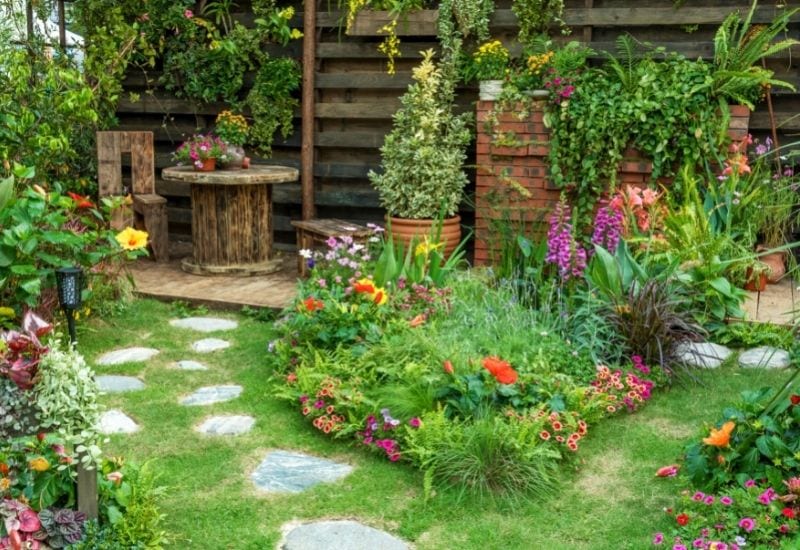
Are you a beginner gardener looking for flowers you can grow easily and with success? Or maybe you are not so inexperienced, but you need some “no hassle” and “safe” flowers?
Low maintenance gardens are a big thing now! Welcome to the right place then, because this article is just about easy flowers to plant when you’re first starting out.
There are a wide range of flowers that even inexperienced beginners can grow. What you need are flowers that need little care, that are naturally strong and that they adapt to your local conditions. As a consequence, most of these flowers come from temperate regions.
Yes, because tropical flowers are usually more delicate.
To simplify matters, we rounded up 20 easy-to-grow, no-fuss flowers that are especially perfect for the beginner gardener, along with our best tips for keeping them healthy so they will fill your flower bed, a porch container or window box with color and fragrance.
20 Easiest Flowers To Plants Your First Garden
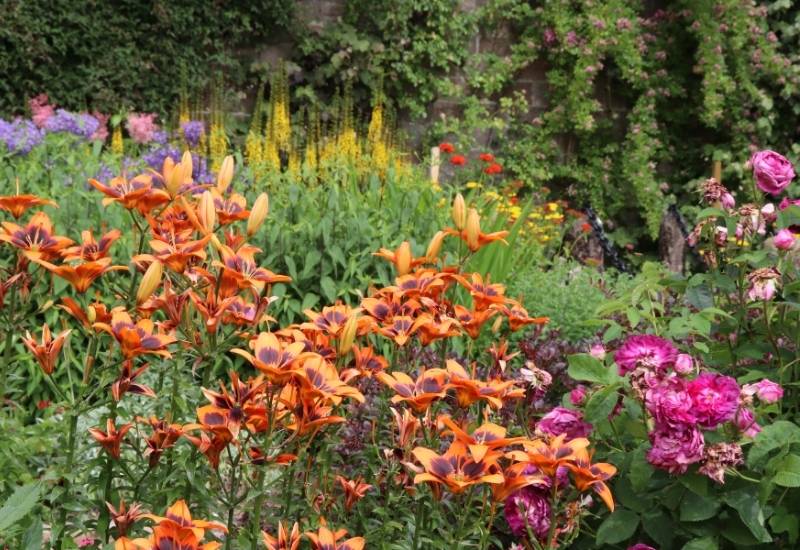
Get ready to grow flowers with little effort and great results then! We did all the hard work for you, in fact. Here are the 20 easiest flowers that anyone can grow, even if your thumb is all but green.
Choose one from our selection, follow the few instructions, sit back, relax and watch it bloom then!
1: Daffodil (Narcissus spp.)
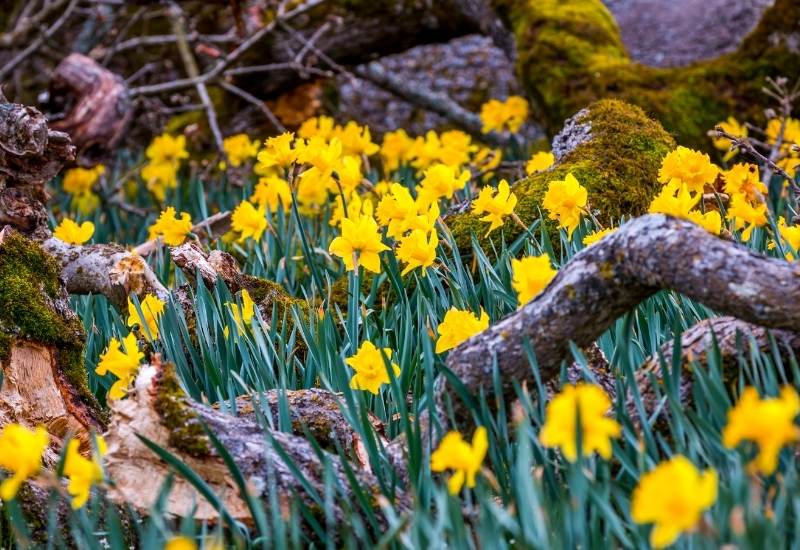
Daffodils are so easy to grow but also so beautiful! In fact, they will grow spontaneously in many areas, and all you need to do is plant some bulbs in your garden and then literally forget about them! They will literally propagate spontaneously and you will get more and more as years go by.
Just sit down, wait and enjoy their colors and amazing smell!
There are many varieties of daffodils you can choose from. Go for natural looking daffodils like large cupped daffodils, small cupped daffodils, poet’s daffodils or Tazzetta daffodils. These are the easiest to grow, and they will not disappoint you!
2: Day Lily (Hemerocallis spp.)
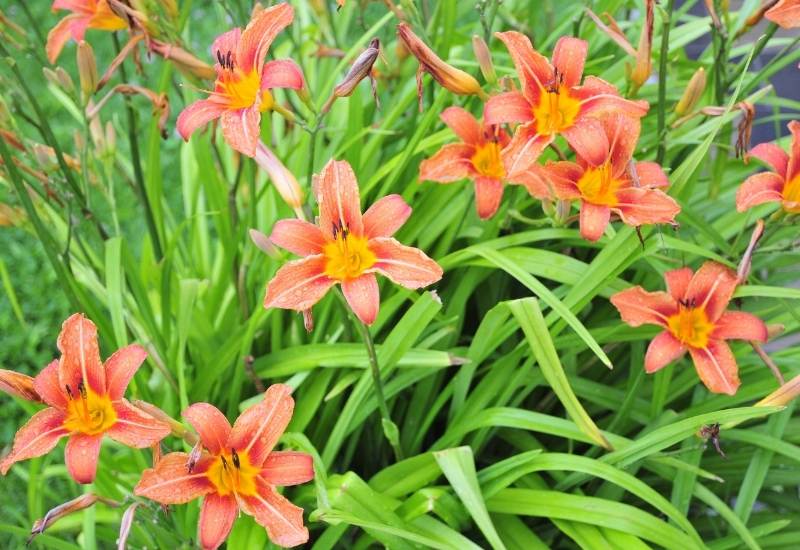
Lilies are picky and hard to grow, but day lilies are super easy! They will form large clumps of beautiful flowers that last one day each. But they are so many and they keep coming, so you will have them for the whole of summer!
They look like lilies in fact, and you can have them in virtually all warm colors, from light yellow to deep purple! And they come back year after year…
Grow them from seedlings. Just plant a small clump and it will soon turn into a massive one. They can fill in a border very quickly.
And when you want to share them with your neighbors, just cut off a few plants when they are not in bloom and off they go to their new home!
3: Bearded Iris (Iris Germanica)
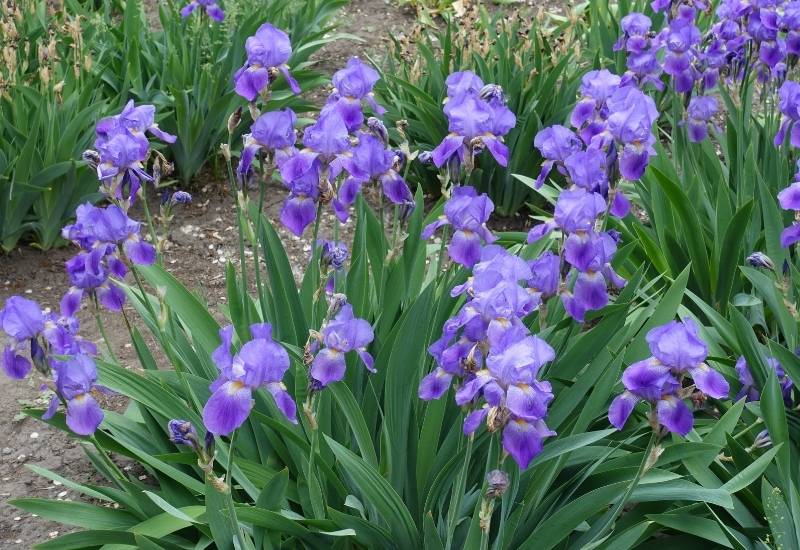
Bearded iris is the easiest iris variety you can ever find! It will grow virtually anywhere, in dry land but also in wet land.
It is cold hardy and evergreen, so you will have its beautiful sword shaped leaves all year round. And you should not worry about blooms either. They will come every late spring no fail!
There are so many different varieties with colors that go from pastel (even light blue) to intense and velvety reds and purples. Variegated flowers are also common and they are all large and showy.
4: Columbine (Aquilegia spp.)
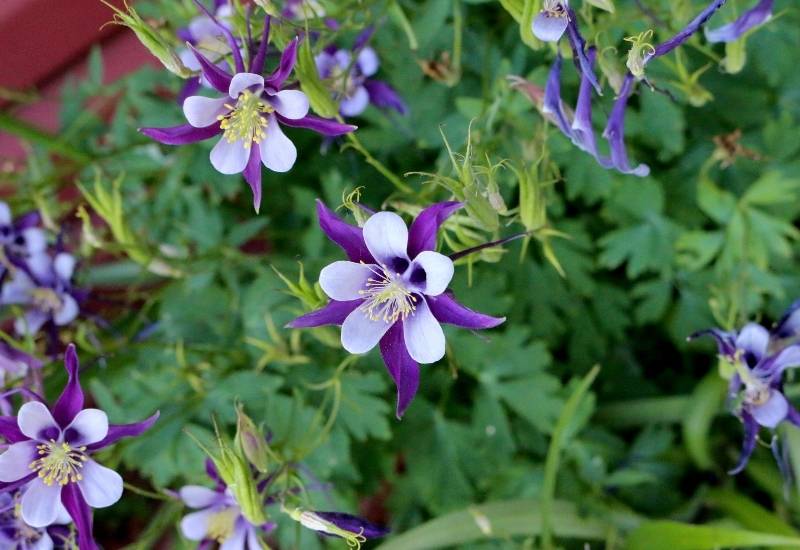
Columbines are very delicate looking but also original looking flowers, and they are also very easy to grow. With their heads with an internal cup of petals surrounded by outer petals often of a different color, columbines are really interesting.
They are ideal for dappled shade places, as they have that “temperate forest “ look… The colors are so many, white, blue, yellow, red and pink in all combinations…
Unlike the other flowers we have seen so far, you can easily grow columbines from seed as well. You are better off using seeding trays in case. Alternatively, plant some seedlings and they will start spreading all over your garden immediately.
5: Ornamental Onion (Allium spp.)
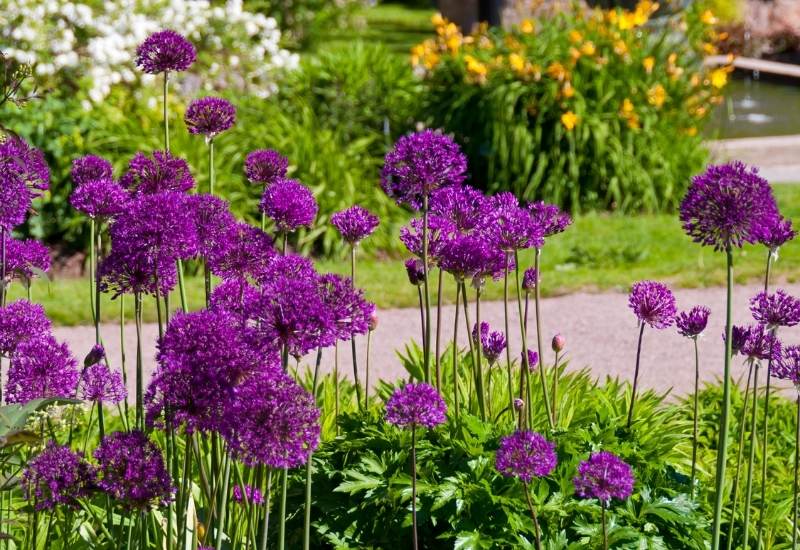
Onions are not just great food, some varieties have very beautiful brightly colored flowers. These come on top of long stems and they form a globular inflorescences of many star shaped flowers.
These can be white, blue, lilac, purple or at times have some green in them. They will look like glitter balls gloating above the foliage.
Just plant the bulbs and your ornamental onions will do all the rest for you. Given their geometrical shape, they also adapt to formal gardens; they look striking in urban gravel gardens in fact, or “garden rooms” if that’s your cup of tea.
6: Marigold (Tagetes spp.)
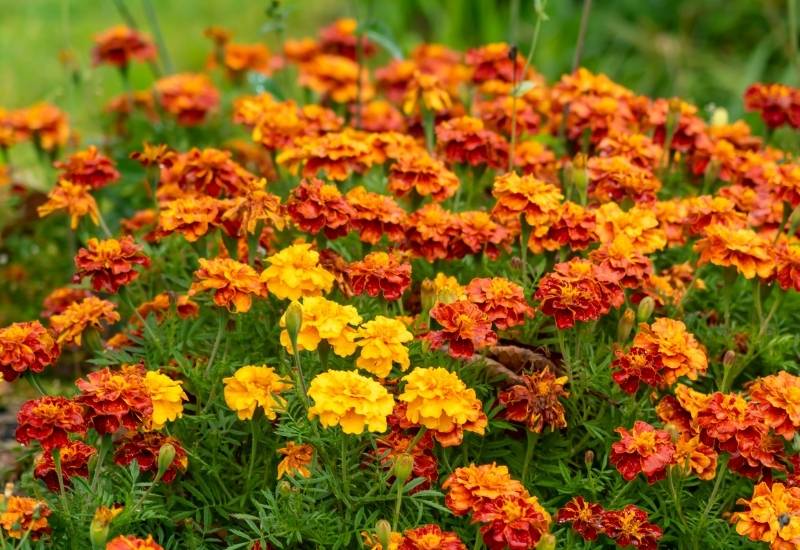
Marigold is a very strong little flower that gives a lot and asks so very little! Its yellow to orange flowers can be single or double, according to the species or variety, but they are always many, long lasting and very brightly colored.
They grow on top of finely textured dark foliage, which makes them stand out perfectly well.
Marigold also has a special quality: it keeps insects at a distance, including mosquitoes! Given its small size, this makes it perfect for window boxes or small borders around your house.
7: Morning Glory (Ipomoea spp.)
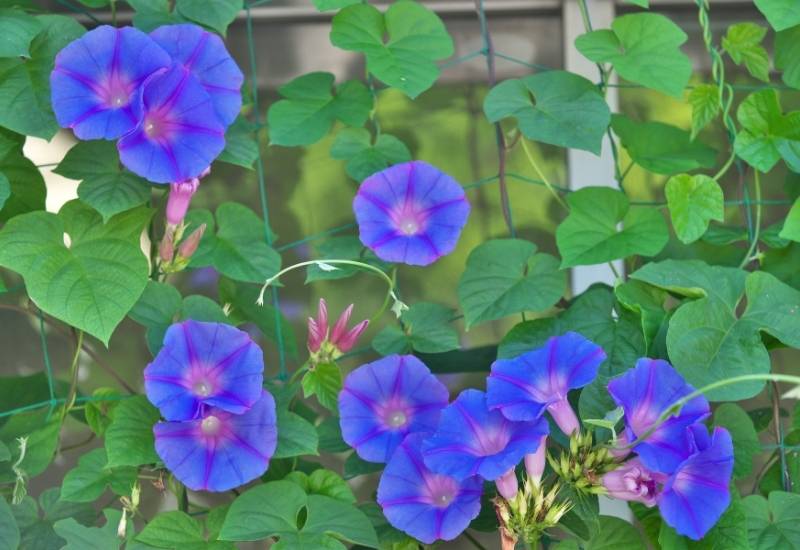
Bell shaped morning glory flowers come in many colors on tender vines with hear shaped leaves. They are perfect for a natural looking garden, in borders but also to climb on fences and trellises.
You can get large ones, with flowers that reach 5 inches across (12 cm) or smaller ones. Famous for their blue and violet colors, there are also white and purple ones.
You can grow morning glory vines straight from seed. They are very string and adaptable.
However, unlike the other flowers so far, morning glory is an annual; keep some of the seeds in the fall, and start again. However it will also self seed.
8: Heather (Erica spp.)
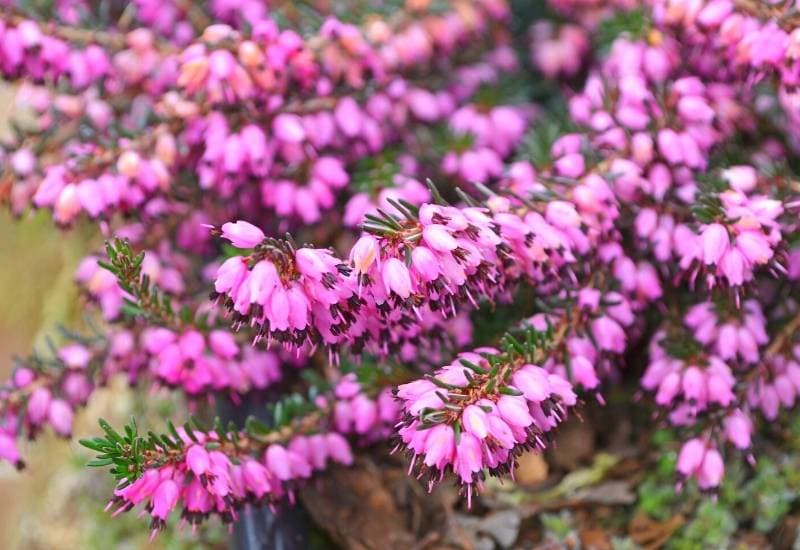
Heather fills with massive blooms cold, wind swept and nutrient poor moors… You can guess that it’s not an easy plant to ruin.
And in fact it is one of the strongest little green friends you can grow. Well, they are green unless they are in bloom. Then they turn totally pink, mauve, white, magenta, or even purple, like carpets of small flowers.
Heather is excellent as groundcover, but also for rock gardens, natural looking flower beds and wild looking areas. It really needs very little maintenance but it blooms for months. And you will get flowers in winter too!
9: Sweet Peas (Lathyrus odoratus)
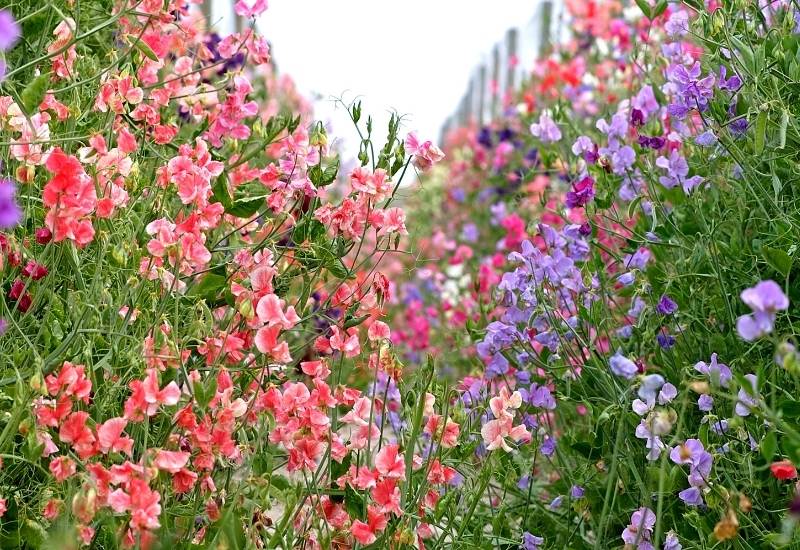
Do you want a massive bloom with very little effort at all? Try sweet peas! They have the most amazing colors, basically all the range of the rainbow, in all combinations.
Each vine will produce an infinity of flowers, starting in spring and going on and on, and on and on… till the first frost! The spectacle is fantastic.
You can literally seed the peas in a tray, then move them to full soil as soon as they reach 6 to 8 inches tall (15 to 20 cm).
Sweet peas too are annuals, so keep some of the little pods (they are actual peas) for next year!
10: Fuchsia (Fuchsia spp.)
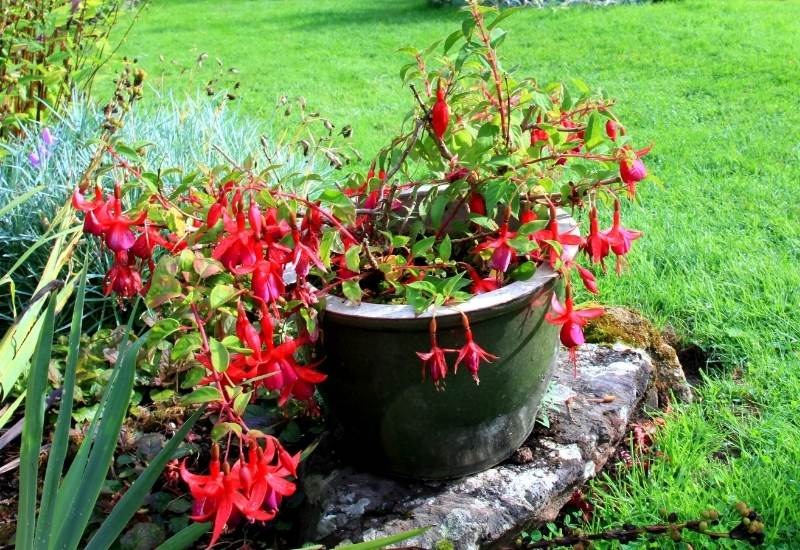
For a perennial shrub with many, showy and unusual flowers year on year, fuchsia plants are easy to grow. The flowers can be of a range of colors, often variegated:
white, red, orange or purple are very popular. They will hang face down from the branches of the shrubs, and the blooms can last till very late in the season.
You can propagate fuchsias easily by cuttings and once the plant has established, you only need to give it basic maintenance, maybe cutting dead or sick branches in the spring.
11: Carnation (Dianthus spp.)
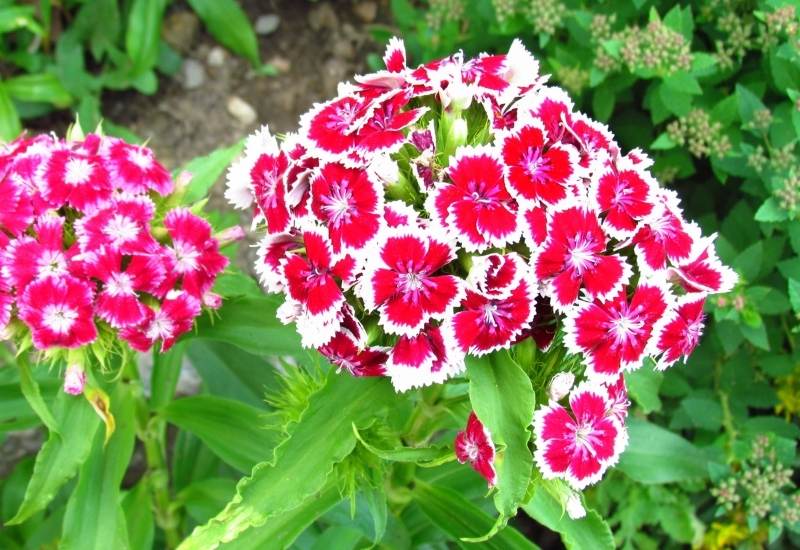
Carnation is an easy to grow generous flower; some species are the most beautifully scented flowers in the whole world. Short, garden varieties, also called “pinks” are particularly easy to grow.
They will grace borders and beds all year round with their beautiful foliage and turn them alive with ling and bright blooms.
You can grow them from seed, using a seeding tray. Alternatively, cuttings and clump division are also common ways of propagating these amazing flowers. Some are even drought resistant, so, perfect for many non labor intensive gardens.
12: Coneflower (Echinacea spp.)
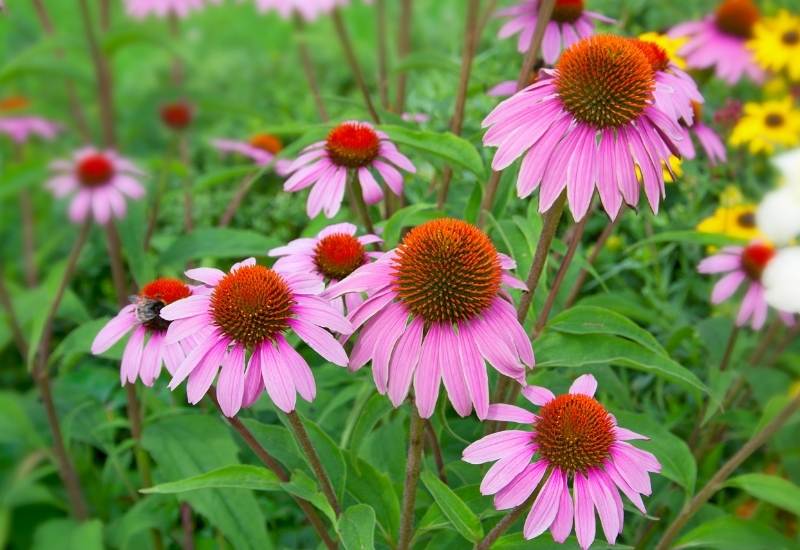
Coneflower is very showy, brightly colored and lively, but it is also a super strong plant. It really wants little care and it adapts to so many different environments, as long as it has enough soil for its roots.
The blooms last for a very long time and, of course, you can take advantage of the medical properties of this plant as well!
Echinacea is easy to grow from seed or clump division. These are usually perennial plants, strong and sturdy, but in some areas they are short lived. Keep the seeds and make sure you have them to replenish them.
13: Lupines (Lupinus spp.)
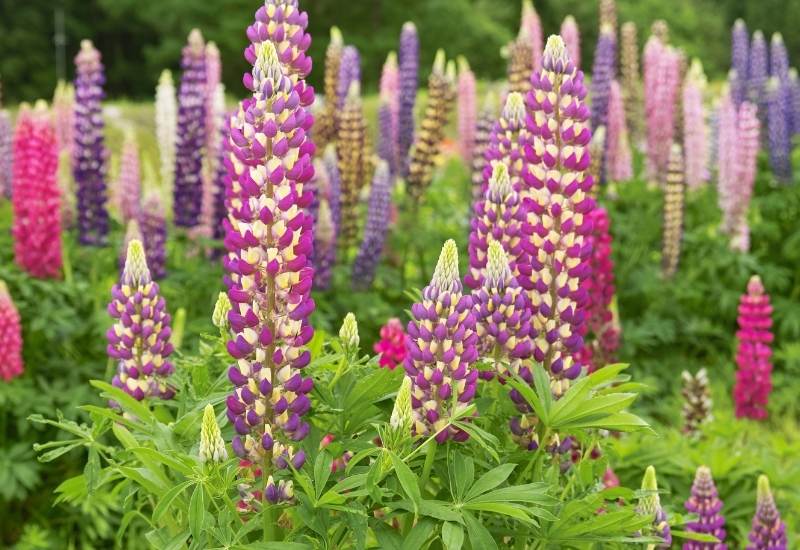
For a natural looking garden, like a cottage garden, lupines are perfect. They come in all sorts of colors, and the long, bright and showy spikes pointing to the sky give a beautiful vertical dimension to flower beds and borders. They also have beautiful foliage, and, you guessed, they are very easy to grow.
They are technically perennials, but they are often grown as annuals. To grow your own soak the seeds in water overnight and sow them in a tray with good soil. Then transplant them when the little lupines have 5 or more leaves.
14: Pansies (Viols spp.)
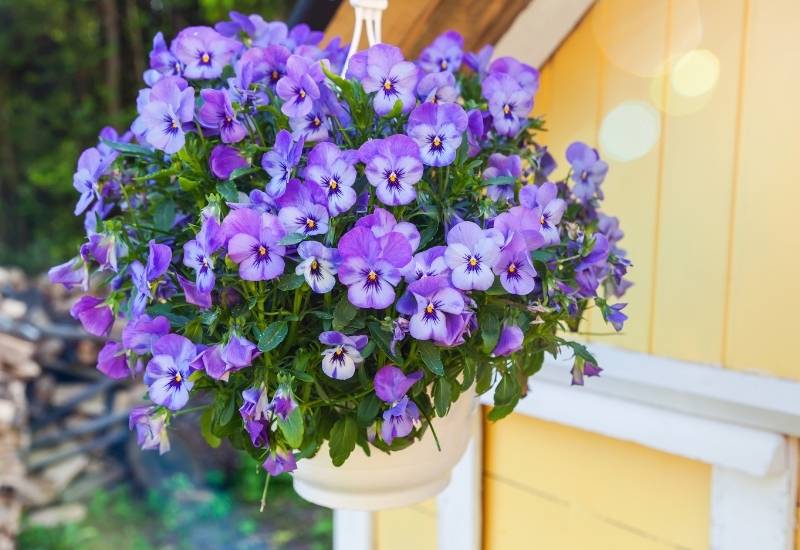
Pansies look delicate but they are very easy to grow. What is more, they will last you for many years and often self propagate.
So, you can have beautiful borders, beds and containers with these striking flowers. As you know, they come in such a massive range of bight and beautiful colors that the choice is almost infinite!
You can grow them from seed, but you can also propagate them by clump division. In all cases, pansies are really low maintenance and amazing bloomers.
15: Hollyhock (Alcea rosea)
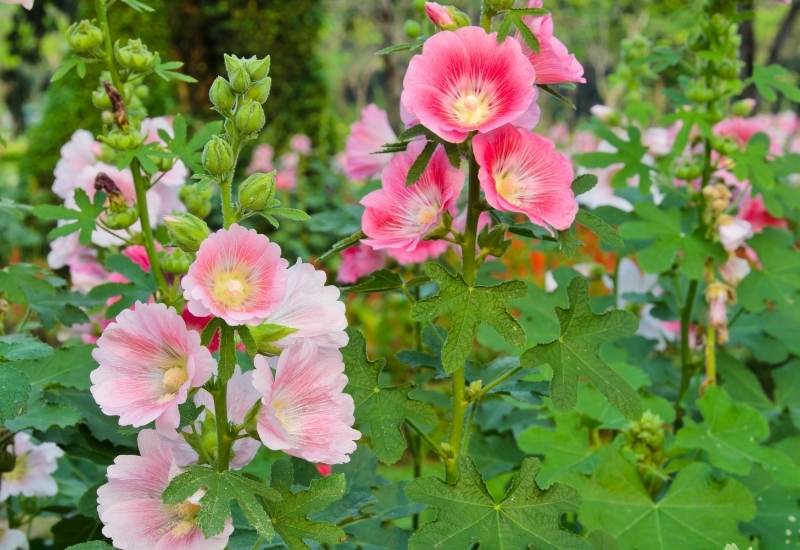
Hollyhock is a very showy, tall flowering plant with massive brightly colored flowers on long spikes. It is so common in cottage gardens that it is almost synonymous with them.
But it is also common in informal borders, or as temporary hedges next to paths, ditches or walls. All the warm colors are available as well as white and variegated varieties.
It is easy to grow from seed, and it will then produce new seeds at the end of summer and in fall. Keep them for next year because hollyhocks are annual flowering plants.
16: Cosmos (Cosmos spp.)
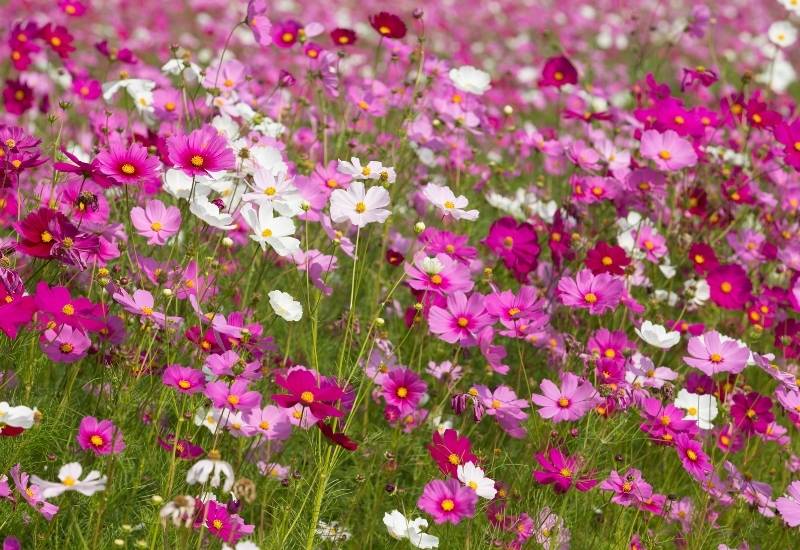
Cosmos is very delicate looking, with daisy like round flowers that seem to hang on a thin net of green stalks. The petals though, are quite broad and they look like they are made of watermarked paper. Few flowers have this delicacy.
But cosmos too is very easy flower to grow, and perfect for informal beds and gardens. The color range goes from snow white to purple.
Just sow the seeds in a tray and then transplant them into full soil when nights are warm enough. Cosmos is another annual flower, keep the seeds then!
17: Sword Lily (Gladiolus spp.)
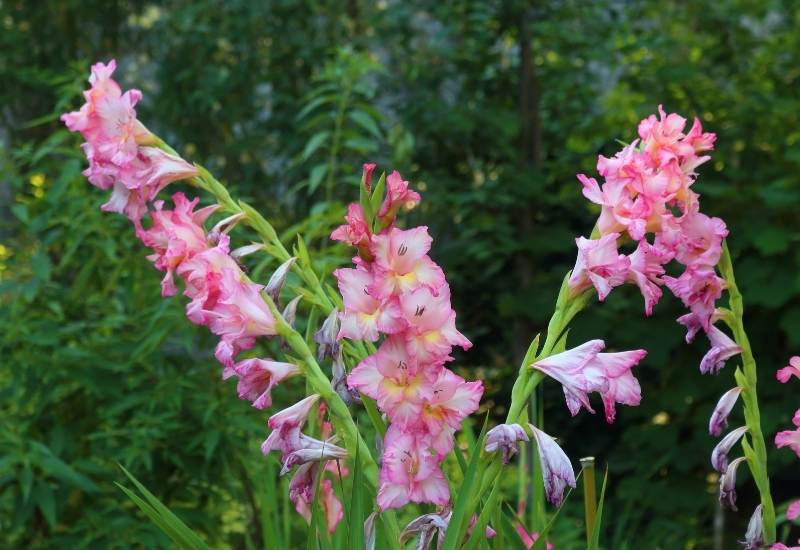
Sword lilies are some of the longest bloomers ever, and that’s why they are common as cut flowers. Well, apart from the amazing range pf bright colors the spikes of flowers offer: from white to dark purple via all warm colors! Some varieties have flowers as big as 5 inches in diameter (12 cm)!
You can easily grow sword lilies from corms, which you just need to take out of the soil in fall, after the leaves have dried up. Store them in a cool and dry place over winter and plant them again next year.
18: Snowdrop (Galanthus spp.)
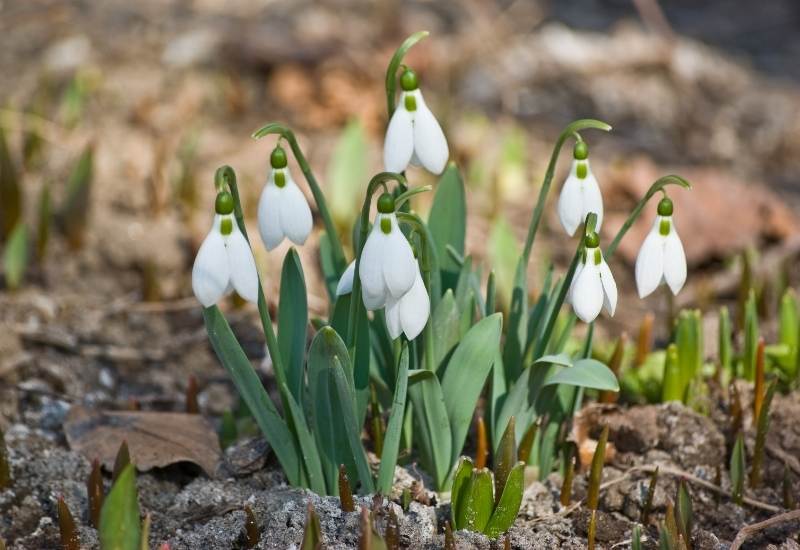
You can have very early flowers with easy to grow snowdrops. True, they look candid and vulnerable, but in fact snowdrops are very strong and low maintenance flowers.
Gardeners only remember about them just after the winter season, when they come back to announce the coming spring.
And they come back in bigger numbers every year, because they naturalize and self propagate very easily!
Just plant the little bulbs in a place you will nit disturb. Let them pop their white heads out every spring over and over again, and grow more and more numerous, till you get a white carpet to follow winter.
19: Petunia (Petunia spp.)
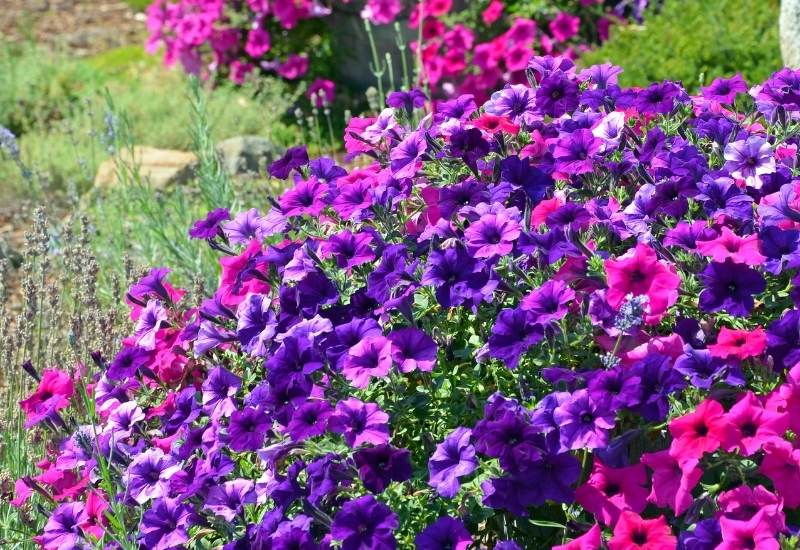
Petunias are marathon bloomers with amazingly colorful flowers. And each plant will produce so many big, showy and large flowers that you can hardly believe your eyes!
They are so undemanding and easy to grow that they have become favorites in hanging baskets on lamp posts and other public places, where they keep growing and blossoming from spring to fall asking only for regular watering.
Petunias are technically perennials, but most gardeners grow them as annuals. You can keep the seeds and sow them again next year.
But sometimes the flowers you get are less showy. Still, a bag of seeds can literally cost as little as a few cents!
20: Hellebore (Helleborus spp.)
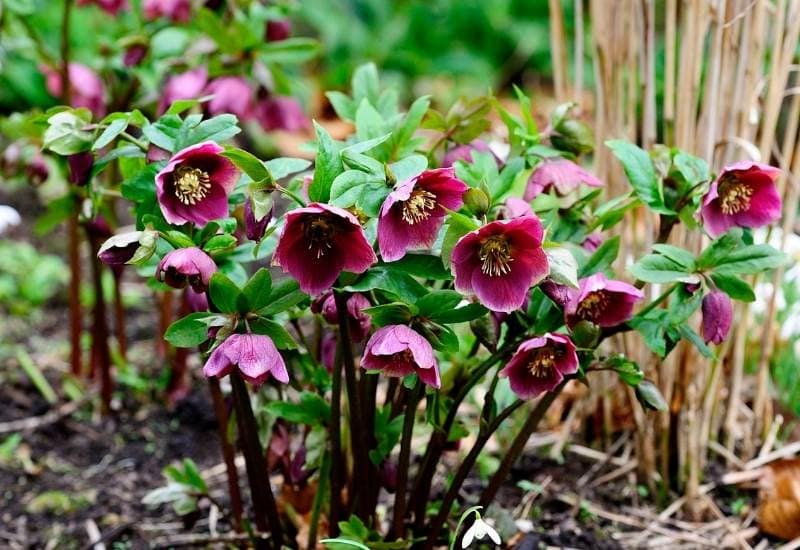
You can have amazing flowers even winter if you grow one of the many hellebore varieties! Yes, this stunning and showy winter flower is very low maintenance and strong!
There are flowers with the most amazing color combinations, and in fact hellebores “specialize” in spectacular but also very unusual and refined colors, including green, coral, brown burgundy and even “black”!
Even if they are famous as “the flowers that bloom in winter” they can keep going all through spring and in colder climates, they can still have flowers in early summer!
Seed or clump division are excellent methods of propagation, and they can naturalize easily too!
Easy but Beautiful Flowers for all Tastes!
How generous is Nature! You can grow all these amazing flowers with very little work and very low risks! They are all stunning, beautiful, and some are very famous too.
You can grow flowers of all sizes, colors and shapes even if you are not an expert. So, don’t be shy now, just pick your favorites and have fun!
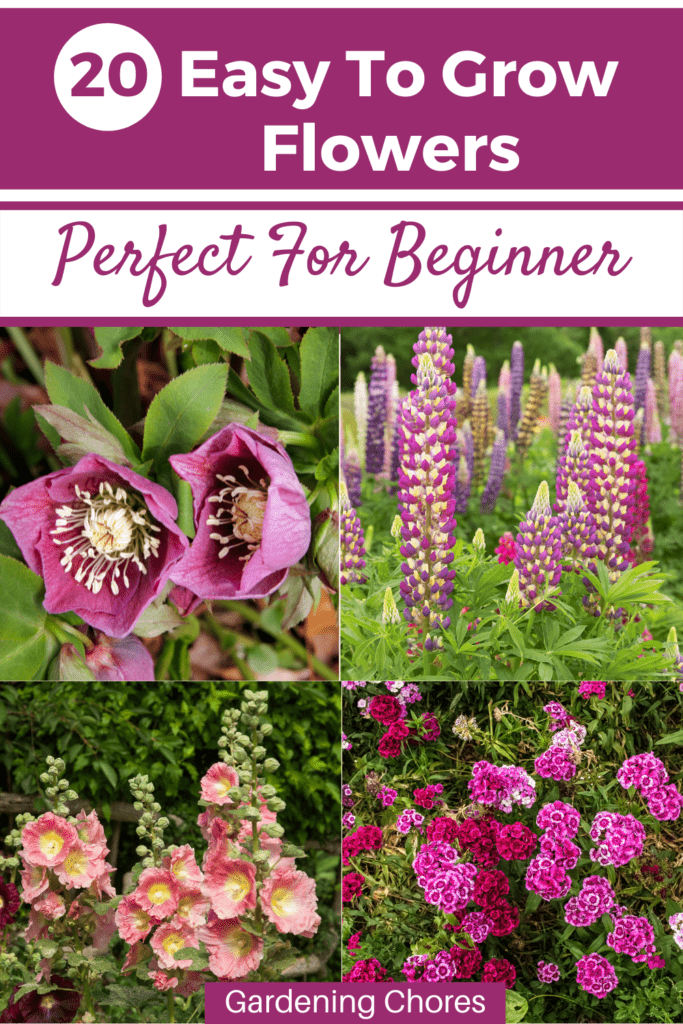

Written By
Amber Noyes
Amber Noyes was born and raised in a suburban California town, San Mateo. She holds a master’s degree in horticulture from the University of California as well as a BS in Biology from the University of San Francisco. With experience working on an organic farm, water conservation research, farmers’ markets, and plant nursery, she understands what makes plants thrive and how we can better understand the connection between microclimate and plant health. When she’s not on the land, Amber loves informing people of new ideas/things related to gardening, especially organic gardening, houseplants, and growing plants in a small space.
